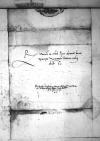List #5730
Sigismund I Jagiellon do Ioannes DANTISCUSZator, 1547-06-16
| odebrano Heilsberg (Lidzbark Warmiński), 1547-06-26 Rękopiśmienne podstawy źródłowe:
| ||||
Tekst + aparat krytyczny + komentarzZwykły tekstTekst + komentarzTekst + aparat krytyczny
Reverendo in Christo Patri, domino
Reverende in Christo Pater et Domine, sincere nobis dilecte.
Probatur nobis, quod Paternitas Vestra iuxta praescriptum nostrum pecuniam ex accisa collectam in castro nostro Marienburgensi deposuit paper damaged⌈[uit]uit paper damaged⌉ fidemque illius commendamus. Erga fratrem Paternitatis Vestrae liberalitate nostra regia libenter usi sumus meritorum Paternitatis Vestrae rationem habentes.
Quam bene valere cupimus.
Dat(ae) or Dat(um)⌈Dat(ae)Dat(ae) or Dat(um)⌉
in
Ad mandatum s(acrae) or s(erenissimae)⌈s(acrae)s(acrae) or s(erenissimae)⌉ maiestatis regiae proprium


 BNW, BOZ, 953, f. 269v
BNW, BOZ, 953, f. 269v